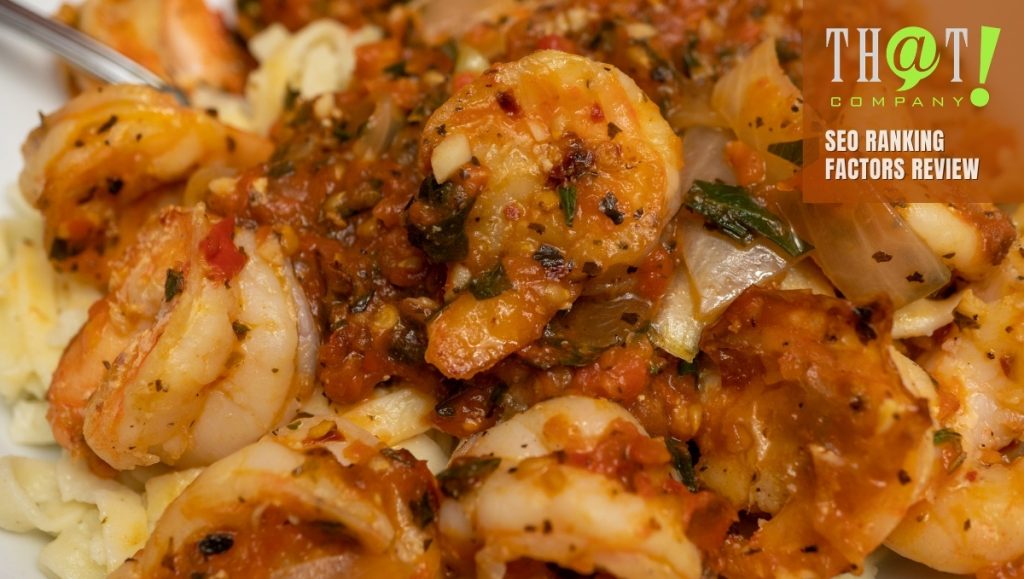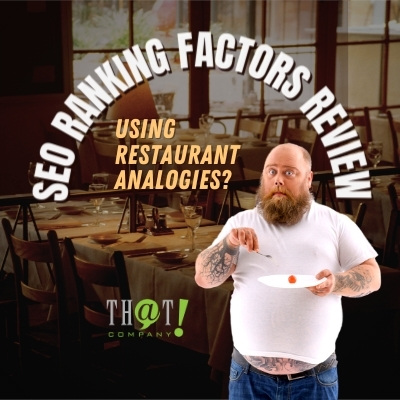 In a June 2017 study published by SEMrush1, shared were the results of a “next level’ examination of SEO ranking factors affecting web page results in Google searches. The study was by no means a cursory look, but rather, a shake and sift of 600,000 harvested keywords from a global field rich in diversity. Placed under the software-driven “microscope” were the first 100 SERP position pages for each keyword.
In a June 2017 study published by SEMrush1, shared were the results of a “next level’ examination of SEO ranking factors affecting web page results in Google searches. The study was by no means a cursory look, but rather, a shake and sift of 600,000 harvested keywords from a global field rich in diversity. Placed under the software-driven “microscope” were the first 100 SERP position pages for each keyword.
SEO ranking factors assumed to be relevant at that time were applied to the study participants. Testing was then applied by a “machine learning algorithm” that generated 17 ranking factors. The publisher believes these have influenced the ranking position for each keyword. These were shared in its report, made available at no cost to the public.
In the world of SEO, the unspoken yet obvious challenge is to discover, deconstruct, or otherwise reveal the “secrets” behind Google’s all-powerful search algorithms. The massive formulas so tightly controlled by the search behemoth’s iron curtain of secrecy have long been sought, hypothesized, and tested. Still, the best one can do is form postulates and measure them by testing. Such testing of ranking factors, however, is predestined to be merely anecdotal. It is of no comparison to the magnitude of data collected and recycled into the world’s largest search engine.
Can the Science Behind the SEMrush SEO Ranking Factor Study Be Trusted?
 In scientific terms, a reasonable question may be, “What sample size would be adequate to form a trustworthy conclusion in testing SEO ranking factors?” After all, one site that calculates Google worldwide searches by the second. Today, it indicates as of 2:42 PM a total of 4,570,620,217 queries were performed. The SEMrush study of 600,000 keywords would represent an extremely small number of those searches, one could assume.
In scientific terms, a reasonable question may be, “What sample size would be adequate to form a trustworthy conclusion in testing SEO ranking factors?” After all, one site that calculates Google worldwide searches by the second. Today, it indicates as of 2:42 PM a total of 4,570,620,217 queries were performed. The SEMrush study of 600,000 keywords would represent an extremely small number of those searches, one could assume.
But, alas, we are speaking of keywords used within searches, not simply searches. Would 600,000 keywords be a sufficient sampling of search activity? If even nine out of every ten keywords searched were identical, that would leave 457,062,021 different search terms as of this 2:42 pm total. That would amount to roughly 13/100ths of 1% of the unrepeated keywords used in this unlikely example. The bottom line is, it is a very small sample—but it’s what we’ve got.
By the way, it is now 3:03 pm and the new global search total is 4,697,503,724.
What Are SEO Ranking Factors?
To claim the results generated by a search query is influenced by solely SEO ranking factors is overly simplistic. It would be akin to claiming one smiles because they are just happy. The evolution of a human smile can be quite complex—and unique—to say the least! There are emotional influences, provoked memories, and biomechanical actions. Any or all of these can transform a face from somber to a smile in a fraction of a second. Each of these main categories of influence can have hundreds or thousands of subordinate influences, to be sure!
In the Technosphere known as the internet, there are some broadly agreed-upon influences to how a keyword ranks as a search result. These are often exploited to attract a higher ranking for a given search term. These ranking factors, when applied properly, have, over time, risen to prominence due to their success in generating results. They are spoken of by SEO Consultants with the same level of familiarity and confidence a doctor does when recommending “rest and plenty of fluids.”
The 17 SEO ranking factors that were evaluated in this study are:
- Direct website visits
- Time on site
- Pages per session
- Bounce rate
- Total referring domains
- The Total backlinks
- Total referring IPs
- Total follow-backlinks
- Content length
- Website security (HTTPS)
- Total anchors
- Keyword in anchor
- Keyword in body
- The Keyword density
- Keyword in title
- Keyword in meta
- Video on page
This is a hefty list to keep in mind, and if you are a new agency, you may be a bit intimidated to take this on by yourself. Fortunately, there are white label SEO services you can call upon to do the wrench-turning while you knock on doors. That Google’s search results follow these ranking factors seems logical when you think about it. The criteria for appearing more prominently favors sites whose message is clear, thorough, engaging, popular, and secure.
This list can generate several analogous examples found in business. The marketing of a website is not so unlike that of a business. To make a dry subject just a bit tastier, let’s apply the factors of keyword ranking to a restaurant. We’ll follow the list from the top.
Direct Website Visits
 How many people visit the restaurant? Is the dining room full and are reservations required? If the place is busy, that must be a sign there is a good meal to be enjoyed inside (or through the drive-thru…gasp!).
How many people visit the restaurant? Is the dining room full and are reservations required? If the place is busy, that must be a sign there is a good meal to be enjoyed inside (or through the drive-thru…gasp!).
Google sees site traffic as one of the most important SEO ranking factors. It is a good sign of popularity, trust (authority), and content of interest. A good “front door” anyway, that is inviting enough to attract a steady flow of “customers.” But consider the opposite—a neglected site with old content, an unattractive home page, or even an unsecured URL. Who wants to dine at a rough-looking joint in a bad neighborhood that serves up spoiled food? When a site has low visitor traffic, its authority may be in doubt, and rankings likely will fall.
Time on Site
Another big influence among SEO ranking factors is Time on Site. This pushes the analogy a little deeper. It is also a more advanced measurement than what Google was observing a decade ago. How much are the customers enjoying their meal within the dining room? They are in the door, seated, eating—but are they satisfied enough to be staying for dessert? Were they impressed enough with a first cocktail to order a second? Did the appetizer menu intrigue them enough to try something unexpected?
Aside from simply getting a visitor to your site, Google wants to have an indication they find it worthy of staying around for a few moments. In fact, the longer one spends on your site, the better. When you find more people are coming to just “eat and run,” you are providing a limited incentive for extended stays. This condition can lead to lost conversions and less potent SEO ranking factor scores.
Pages Per Session
In your favorite dining memory, you were likely to have been delighted by a better-than-expected experience. You may have stopped in for a quick dinner but found an intriguing atmosphere with comfortable seating. You marveled at a creative menu offering a selection of entrees from which you were eager to choose. Your waiter interacted with you and made recommendations based on your interests. The perfect wine was delivered to your table at exactly the right moment. Your meal was an experience, not simply food. Time went by and you didn’t even notice.
Google likes “fine dining,” too, and it rewards sites that sustain visitor interest. Improving “Time on Site” is accomplished by extending the total amount of time a browser spends on a site during a given session. It correlates to higher rankings. It is the duty of a good host—webmaster or dining room manager— to provide a superior experience that will give guests a reason to stick around and even return. Pages Per Session is another top influencer among SEO ranking factors.
Bounce Rate
 We now turn to the most regrettable dining room event one can witness—the walkout. If an experience is that bad, something must be done to correct it. The worst thing you could do is fail to deliver the initial service one expects and just watch as they abruptly walk out the door.
We now turn to the most regrettable dining room event one can witness—the walkout. If an experience is that bad, something must be done to correct it. The worst thing you could do is fail to deliver the initial service one expects and just watch as they abruptly walk out the door.
At worst, a “bounce” to Google is akin to a “walkout” in a restaurant. At best, it is picking up a carry-out bag at the door without stepping inside. Defined, it is a visit to no more than one page, followed by an exit. It drops your time on-site ranking factor harshly, and Google’s impression of this is like the collective turned heads in the dining room watching as that party just exited with disappointment written on their faces. Just like a good dining room manager, your job is to intercept a bounce and give the browser a compelling reason to stay awhile and look around.
Total Referring Domains and Referring IPs
Google appreciates a solid consensus when it comes to opinions, and really, don’t we all? A vote of confidence in a world of websites is clearly identified by a backlink: The referral or invitation to visit your site, given from a site other than your own. Referring domains and IPs are SEO ranking factors that apply to site authority.
We are familiar with referrals from doctors to specialists, of course. In fact, a single doctor may have a network of expert specialists to whom he or she may send patients for exemplary care in a focused area of healthcare.
So too, can a single domain refer to multiple sites. Each domain has a reputation that stands behind the referral, as would be the case with a doctor. A referral from a domain of questionable authority and intent would not carry as much weight in Google’s algorithmic eyes as a well-respected domain. There is also a negative impact from domains that tend to give too many referrals (backlinks) indiscriminately. Consider the value of a single, strong, and convicted recommendation versus a list of 100 “great specialists” your doctor shares.
Total Backlinks and Total Follow Backlinks
Examine the social network you enjoy most and within seconds you can find opinions and reviews of just about anything. It is no surprise that “word of mouth” has evolved into “sanctioned” mass ratings on numerous platforms from Amazon to Zillow. Ratings influence us deeply today, and individual backlinks are a form of rating, though not publicly quantified, officially. Google still sees them as endorsements to include in its calculations.
If your restaurant is doing well, and you have the business running like a well-oiled deep fryer, you will get a virtual buffet of feedback from various sources. Of course, Google’s own review area (in Google My Business accounts) commonly rises to the top of results. There are other points of origin, like directories, neighborhood groups, trade groups, published reviewing journalists, and the backlinks they often use.
A backlink profile that is broad and from good, reliable sources is a big positive plus among SEO ranking factors. It can have the effect that adding more displacement to an engine would on its horsepower potential, and as the SEMrush study shows, at higher RPMs (i.e., keyword volumes), it acts like a turbocharger.
Yes, word of mouth still exists, but it also has a formal place to live a long and influential life online.
Content Length
 Taking a small taste of my spouse’s entrée does not always give me the satisfaction I would have if I had ordered an entire plate of her meal. But I always order something different. I am a “foodie,” driven by a variety of tastes and experiences. Her dinners are always better, it seems.
Taking a small taste of my spouse’s entrée does not always give me the satisfaction I would have if I had ordered an entire plate of her meal. But I always order something different. I am a “foodie,” driven by a variety of tastes and experiences. Her dinners are always better, it seems.
The traditional sampling of her meal is often spotted with disappointment, however. This is because it is usually impossible to gather the entire gastronomical moment upon the tines of a single fork delivery to my mouth—and that’s all I get these days—one taste. Fettuccini Carbonara without the strand of bacon is Fettuccini Alfredo, really. It is incomplete and does not convey the entire definition of the chef’s intent.
Content length is one of the core SEO ranking factors, and it applies to your website. A vision that remains largely in your mind and not in readable text form is a vision unseen by Google. Google needs a textual mouthful of content to form its opinions as to what you are selling or trying to say. If you give it an incomplete taste, it may conclude wrongly, but more likely, it will just let your keyword ranking slide down the ladder into obscurity.
Google has an insatiable appetite for content. Nouveau Cuisine, with its artful yet diminutive plating of esoteric ingredients, is not going to satisfy the voracious hunger of Google’s web-scrubbing bots. If your site doesn’t say what you intend people to know, Google will most certainly treat the site like a snooty food critic.
Website Security (HTTPS)
It goes without saying that you want to be safe inside of a dining establishment. You don’t want peddlers coming up to you during your meal, looking to sell you a timeshare (do you?). Most would expect no surprises when the check is delivered by the server, either. You would prefer to pay by credit card? Perfect, you hand it to the server, and they whisk it away to a concealed corner to run the tab. Do you worry about the security of your credit card at this critical moment?
If the restaurant is unknown to you, maybe so. Perhaps you stopped for a quick lunch at an independent sandwich shop located on a backroad to an ancient ruin on the first full day of your vacation abroad. You don’t want to run low on cash, so you whip out the MasterCard as if you were a mile from home. But you aren’t, and you don’t even recall the name of the place you are standing in. Sweat begins to bead on your forehead and your heart begins to beat faster.
Secure Transactions: A Must Have
The anxiety is real because bad things can and do happen. They occur on the internet also, and we all know it. In maintaining a consumer “best practice mindset,” shouldn’t we all adhere to restrict our online purchases to sites that are secure? A URL with the addition of an “s” after HTTP indicates it is a site that has retained a security certificate. Any data that moves between web servers and clients is encrypted. That would be like walking your credit card back to the terminal with your server, which may not be such a bad idea itself. Security may not be found in multiple SEO ranking factors, but for now, this one covers it well enough.
Total Anchors & Keyword in Anchor
 Again, we must respect the issuance of recommendations by others. It is encouraging to hear a friend say, “There are many great Chinese restaurants in Chinatown!” when you are hungry. The problem is, there may be two dozen Chinese restaurants, side by side for three blocks. Which one is the best?
Again, we must respect the issuance of recommendations by others. It is encouraging to hear a friend say, “There are many great Chinese restaurants in Chinatown!” when you are hungry. The problem is, there may be two dozen Chinese restaurants, side by side for three blocks. Which one is the best?
However, what if your friend says, “There are many great Chinese restaurants in Chinatown, and the best Dim Sum on weekdays is at Lucky Dragon”? You now have a specific recommendation that stands apart from a generalized endorsement. If you are on the hunt for Dim Sum on a Wednesday, you’ve just struck gold. You hug your friend and dash to catch some sticky rice wrapped in a lotus leaf.
As the web allows, endorsements like these exist in the form of backlinks, as discussed earlier. Among SEO ranking factors, the total number of anchors—the text linked from another site to yours—positively impacts ranking as the total grows. In fact, the SEMrush study showed that the total anchors for search terms, at all levels of search volume, more than doubled between a rank of 20 versus a rank of 3.
The specificity of the anchor adds a positive bump in value, too. The same study shows that long-tail keywords (those that tend to be longer and more specific) were reported at volumes three times greater when the term was ranked in position three than when it was ranked 20th. Now that’s some tasty Dim Sum!
[bctt tweet=”If your content does not have a designated keyword upon which you have shined a brilliant light using headings, titles, and body content use, you may be serving mystery chowder to an empty dining room.” username=”ThatCompanycom”]Keyword in Body & the Keyword Density
I am a bit of a Clam Chowder snob. I grew up eating a fair amount of seafood, living on the Atlantic in New England. The chowder was often made with fish, scallops, crab, and lobster (unless the recipe turned these into “bisque”), but they were all served “New England style,” in a rich, creamy base.
 The other day, a neighbor was kind enough to offer me a generous portion of clam chowder she had made that day. I willingly accepted and later that evening reheated a bowl for my dinner. It had the appearance of a good chowder, and in fact, it was a decent attempt at creating chowder. Unfortunately, it was not convincingly a clam chowder, as it had only a trace amount of clam bits in the overly-flour-thickened base. Naturally, I was disappointed. Had her offer to me been a container of potato chowder, I might have considered it a success, but alas…
The other day, a neighbor was kind enough to offer me a generous portion of clam chowder she had made that day. I willingly accepted and later that evening reheated a bowl for my dinner. It had the appearance of a good chowder, and in fact, it was a decent attempt at creating chowder. Unfortunately, it was not convincingly a clam chowder, as it had only a trace amount of clam bits in the overly-flour-thickened base. Naturally, I was disappointed. Had her offer to me been a container of potato chowder, I might have considered it a success, but alas…
Put Clams in Your Chowder!
The content on your website, or page, or blog post should have intent, ideally. Much like this article, written to deliver emphasis and ranking to the term, “SEO ranking factors,” your content should have a goal in mind. A good story is even better when it can be read, right? If your content does not have a designated keyword upon which you have shined a brilliant light using headings, titles, and body content use, you may be serving mystery chowder to an empty dining room.
“How much is enough?” I recall asking my older sister when she shared her clam chowder recipe with me at an early age. “How do I know there are enough clams in the chowder?”
The answer, whether it is content creation, chowder, or cologne, is to use enough to be noticed, but not so much as to make one gag. Keyword density directs us to a more scientific answer, fortunately, and it can be measured by the number of instances a keyword is used divided by the total number of words on the page. More specific calculations are used when the keyword is made of more than one word, but for a single keyword, this writer will target between 1.5% to 3%.
If you add the keyword too many times, Google may very well see the article as spam and treat it quite poorly. Use it too sparingly, and it may not be “convincing enough” to merit a Google ranking. The use of the keyword in the body should also be mixed well—not clumped in only one section of the page. Just imagine not allowing a seafood-flavored bouillon cube (gasp!) to melt and be mixed thoroughly in your chowder. The horror!
Using the Keyword in the SEO Title
Back to the restaurant for a moment or two… You are seated at your table by the maître d’, and within seconds you are handed a menu. Imagine your surprise and confusion when all the available food is described by only the ingredients used, and not the name of the dish. Informative, yes, but how, exactly would you convey your order to the server?
 “I’ll have the dinner with shrimp, olive oil, crushed red pepper flakes, onion, diced tomatoes, dry white wine, oregano, Italian parsley, and basil, please,” you say.
“I’ll have the dinner with shrimp, olive oil, crushed red pepper flakes, onion, diced tomatoes, dry white wine, oregano, Italian parsley, and basil, please,” you say.
By the time you finish and look up from the menu, the waiter has left, headed to the kitchen to fetch an order for another table. It would have been so much simpler if the menu had just named the entrée “Shrimp Fra Diavolo.”
Sure, you will eventually get your order in and dinner will follow, but what about the experience? There was something missing, and the process was rather forgettable. On the other hand, just saying “Shrimp Fra Diavolo” feels pretty good. You may not speak Italian, but at that moment, you conjured the depth of Luciano Pavarotti in requesting a most exquisite meal.
Be Good to Your Keyword—Use it in Your SEO Title
SEO ranking factors like SEO Title (the bold-faced first line of a typical Google search result) are important out of consideration to the browser, I believe. It continues the theme of favoring the site visitor, the customer if you will. A clear and direct SEO Title delivers confidence that the content will be aligned to what was searched.
While a high bounce rate will merit a penalty, offering a direct and accurate description of what one might expect to find on a web page is just “good business,” plain and simple. As SEO ranking factors go, this is statistically benign. It appears more intended to serve as a gesture of “good form” rather than a technical policy to follow.
In so doing, keeping the keyword toward the beginning of the SEO Title delivers your intent more quickly and conveys greater emphasis. Order by the name of the dish, not its ingredients.
The page H1, most often found at the top of a page, should be treated in a similar fashion. This headline is often referred to as the “title” too (but it is not the same as the SEO Title or Meta Title, two terms that are often used interchangeably), and it should contain the keyword as well.
Presence of the Keyword in the Meta Description
If you were allergic to peanuts, it would be important to you for a menu item to include a mention of peanuts as an ingredient within the description. Not every ingredient is listed on a menu for every entrée, but where they are, it can help in decision-making.
With Keyword in Meta Description research, we see SEMrush data that minimizes this SEO ranking factor’s relevance. However, without adding helpful and well-built Meta Descriptions, the browsing world would be in a spiral of chaos, would it not? How reliable would search results be if these pixel-constrained vignettes were inaccurate, incomplete, or even missing altogether? Obviously, they are needed, and the data shows slight improvements in ranking positions for results that have the keyword within their meta description, so why not make this your practice?
Video on Page
 A fine-dining experience from decades ago may have featured a live band playing music that would add to the ambiance and experience of the meal. Today, though fewer and farther between, so-called “Dinner Theaters” combine eating with entertainment to attract customers. In my own experience as a kid, I watched fire dancers perform on a stage in a Polynesian restaurant. None of these examples are essential to dining, but the idea is to offer a greater experiential value.
A fine-dining experience from decades ago may have featured a live band playing music that would add to the ambiance and experience of the meal. Today, though fewer and farther between, so-called “Dinner Theaters” combine eating with entertainment to attract customers. In my own experience as a kid, I watched fire dancers perform on a stage in a Polynesian restaurant. None of these examples are essential to dining, but the idea is to offer a greater experiential value.
Online, we have video, and in many cases, it attempts to fulfill a similar role. Concepts that benefit from a deeper examination or are more attractively shared by the use of a more dynamic method than simple text falls into the realm of visual content. A “thousand-word” picture is very quickly a “million-word” video, and for some sites, users expect content that is beyond text.
The SEMrush data indicates, however, that video content was not a panacea to site traffic or search results. For the moment, Google may not have the capacity to extract reliable content from a video (spoken or seen as graphics) to include in its mighty algorithm. Thus, Video on Page was last among SEO ranking factors in terms of influence. But check back in a few years…or less.
SEO Ranking Factors in Review
In this reverse-engineered view of what makes a Google search result rank, we still speculate, but with a reasonable degree of confidence from practical experience. The SEO ranking factors that seem to be most relevant at this time appear to be those that underscore popularity, first, measured by:
- Direct Website Visits
- Time on Site
- Pages per Session
- Bounce Rate
The second grouping would tend to lean toward reputation and authority, as indicated by:
- Backlinks
- Total Referring Domains
- Total Referring IPs
- The Total Follow-Backlinks
- Content Length
Rounding up the list are factors that include keyword placement and presence:
- Keyword in Body
- Keyword Density
- The Keyword in Title
- Keyword in Meta
What’s Coming Next in SEO Ranking Factors?
The outlook for SEO Ranking Factors may yet be undefined. However, there are solid indications of what Google might be favoring next. Evidence indicates it applies to a deeper commitment to user experience. The customer is first, after all. The pressure is increasing in the coding department, too. Fortunately, there are white label web design firms available to help coordinate solid code with optimized content simultaneously. This opens the door to many firms to consider becoming a white label SEO reseller who utilizes their time to close more contracts while the work is done for them in the background.
- Enhancements to usability that include a dedicated “Mobile-First” web design, as more browsing traffic emanates from smartphones and tablets, appears to have a solid foothold already. Expect that to grow and continue to be refined.
- Fine-tuning the backside. “Core Web Vitals” are tracked and reported in Google Search Console. These call out deficiencies in the code-related loading and speed of a site and its pages. The stability of the elements on a page during load is tracked as well. Consequently, jittery text or fonts that load and abruptly change are frowned upon.
- SERP Features: Too Many, How Many, How Long? The gold-rush of search result real estate is claiming a SERP nugget like a Featured Snippet, Top Story, Q & A extension, and others. Will Google continue to support this extra recognition that comes only via page 1 ranking and savvy structured data placed on the ranking page?
The days of the burger stand with a billboard are over. Today’s successful “restaurant” (website owner) must continue to refine and intensify its focus on SEO ranking factors. The goal is to improve its reputation, reviews, atmosphere, and service, all while creating a consistently good experience that is well-delivered and presented. It’s a tall order that many will fail to even consider. Those that do will most likely find a narrowed field of competition and even greater results in their favor.
The Author, Jay Wiencko, is an SEO Consultant with That! Company.
1 https://www.thewebconsulting.com/media/media/SEMrush_Ranking_Factors_Study_2_0.pdf






























